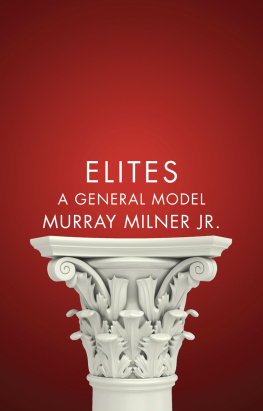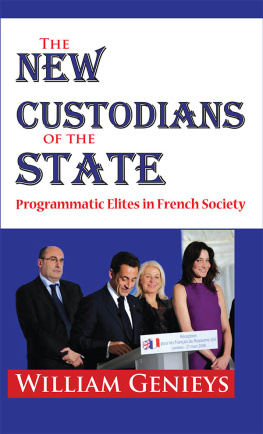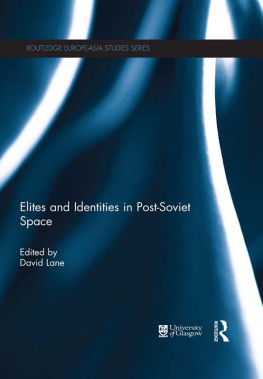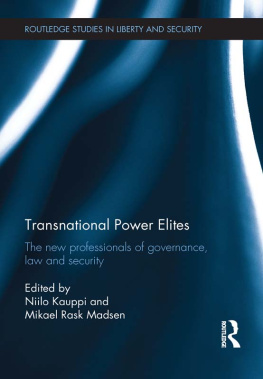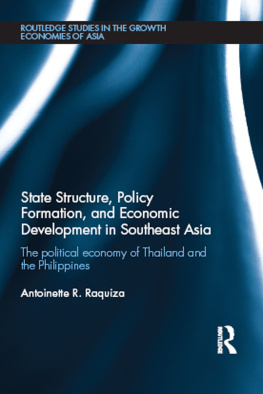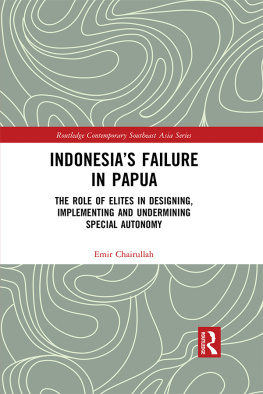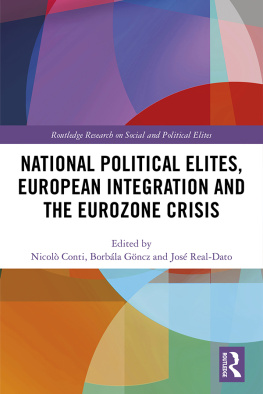
For the non-elites
Copyright Murray Milner, Jr. 2015
The right of Murray Milner, Jr. to be identified as Author of this Work has been asserted in accordance with the UK Copyright, Designs and Patents Act 1988.
First published in 2015 by Polity Press
Polity Press
65 Bridge Street
Cambridge CB2 1UR, UK
Polity Press
350 Main Street
Malden, MA 02148, USA
All rights reserved. Except for the quotation of short passages for the purpose of criticism and review, no part of this publication may be reproduced, stored in a retrieval system, or transmitted, in any form or by any means, electronic, mechanical, photocopying, recording or otherwise, without the prior permission of the publisher.
ISBN-13: 978-0-7456-7182-6
ISBN-13: 978-0-7456-7183-3 (pb)
ISBN-13: 978-0-7456-8952-4 (epub)
ISBN-13: 978-0-7456-8951-7 (mobi)
A catalogue record for this book is available from the British Library.
Library of Congress Cataloging-in-Publication Data
Milner, Murray.
Elites : a general model / Murray Milner, Jr.
pages cm
Includes bibliographical references.
ISBN 978-0-7456-7182-6 (hardback : alk. paper) ISBN 978-0-7456-7183-3 (pbk. : alk. paper) 1. Elite (Social sciences) 2. Power (Social sciences) 3. Elite (Social sciences)United States. 4. Power (Social sciences)United States. 5. Elite (Social sciences)India. 6. Power (Social sciences)India. I. Title.
HM1263.M554 2014
305.520973dc23
2014015223
The publisher has used its best endeavors to ensure that the URLs for external websites referred to in this book are correct and active at the time of going to press. However, the publisher has no responsibility for the websites and can make no guarantee that a site will remain live or that the content is or will remain appropriate.
Every effort has been made to trace all copyright holders, but if any have been inadvertently overlooked the publisher will be pleased to include any necessary credits in any subsequent reprint or edition.
For further information on Polity, visit our website:
politybooks.com
Preface
I am always a bit suspicious of authors' descriptions of why they write what they do, including my own accounts. There is a tendency for most of us to underestimate the effects of social context, contingency, luck, and providence in what has happened at least when it is linked to the completion of a project for which we can and must take credit. With this reservation and warning, I want to state what I now see as the influences that led to this book. While I was never a scholar who specialized in studying sociology's intellectual ancestors, for a number of years I taught courses in classical social theory. I was always struck by the differences in how Marx, Pareto, and Weber understood the link between social inequality, social conflict, and social change. Each one was extremely insightful, but I sensed that they told only part of the story. It was a number of years, however, before I considered trying to create a more complete picture. The second stimulus to this book came out of my study of the Indian caste system. The idealized indigenous description of castes at least by those from privileged castes draws on what is usually referred to as the varna system that suggests that there are four social categories of people and each one is called upon to carry out a particular social function. This scheme has been influential for several thousand years even though there is only the vaguest link between this idealized description and the actual organization of castes in village India. It was the interactions between these two stimuli my questions about classical theories and my puzzle about how something as inaccurate as the varna system could continue to be the standard description of the caste system that led to this book.
I also frequently taught courses in social inequality and became reasonably familiar with the literature on contemporary power elites and ruling classes. I often agreed with this literature I think power in many contemporary societies is far too concentrated and unchecked but the questions that I was asking seemed unaddressed. It seemed to me that the concentration of power, and many other important phenomena, derived, in part, from the patterns of conflict and cooperation between various types of elites and between elites and non-elites. Moreover, recurring patterns seemed to exist across a number of very different societies. That is a central focus of this book. There are three additional emphases. First, most treatments of elites and ruling classes do not give enough attention to non-elites. Second, elite theory tends to focus on economic and political elites who are obviously important but to ignore other important categories of elites. Third, class analysis can usefully be subsumed within a model of elites. To deal with these issues I am proposing a new model of elites and non-elites. The sources, content, and application of this model to three very different societies is the subject of this book.
I am indebted to many people: some because they encouraged me, some because they made me think harder about what I was doing, and some for a lifetime of personal support. To name all of these would both strain my memory and bore my readers, but some must be named. I learned much from the graduate students in a course I taught on several occasions called Elites and Non-elites. Paul Kingston, Simone Polillo, and Rae Blumberg provided useful critiques on earlier abbreviated versions of this work. Even though much of the year he lives in Italy, my good friend Gianfranco Poggi has phoned about once a month, in part to inquire about how the work is progressing, implicitly providing a much needed and much appreciated reminder that I needed to get the book finished. Jon D. Mikalson of my university's Classics Department provided invaluable advice and guidance, including reading several versions of the chapter on Classical Athens. He was the very model of a good colleague. Another longtime colleague James Davidson Hunter has provided me an office and encouragement at the Institute for Advanced Studies in Culture, an especially congenial and stimulating work setting. Mieke Thomeer and Megan Quetsch served as outstanding undergraduate research assistants and were of great help in finding sources and proofreading. I am also appreciative of the help and guidance provided by Jonathan Skerrett of Polity Press and the careful copyediting of Ian Tuttle. As always, I am indebted to Sylvia Milner for a lifetime of companionship.
Introduction
Introduction
Two of the recurring issues in social theory are (1) who has power and (2) how does the exercise of such power shape subsequent events? In an attempt to answer these questions, analysts have drawn on the concepts of class and elite. Sometimes these are made more specific by notions of ruling class and power elite. Often the analyses of classes and elites are linked to implicit or explicit arguments about what produces or limits social change. Some of the factors focused upon include production technology, weaponry, demography, and culture. The notions of class and elites have produced insights into the nature and direction of social life, but they seem increasingly inadequate to understand the complexity of contemporary social life. Moreover, they have been inadequate for understanding both the commonalities and the differences between societies, and between the past and the present.
Next page
